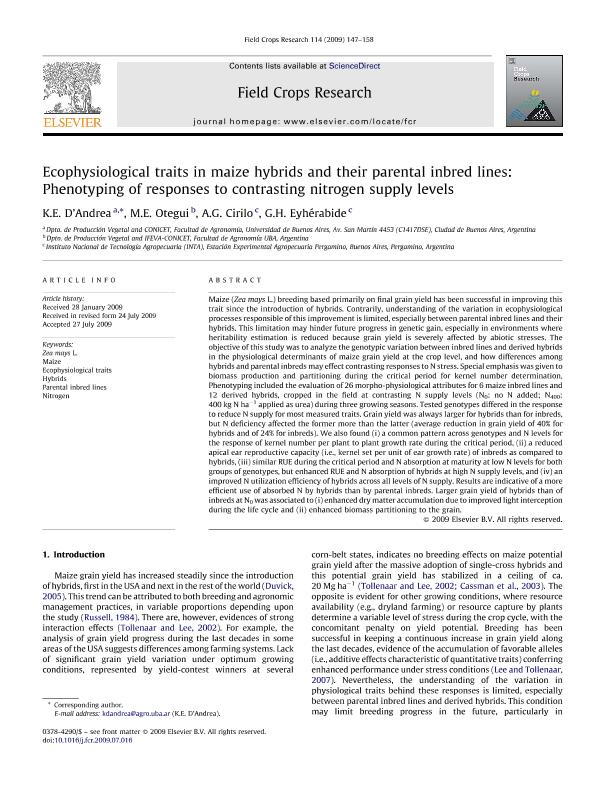Mostrar el registro sencillo del ítem
dc.contributor.author
D'andrea, Karina Elizabeth

dc.contributor.author
Otegui, Maria Elena

dc.contributor.author
Cirilo, Alfredo Gabriel

dc.contributor.author
Eyherabide, Guillermo Hugo

dc.date.available
2022-02-16T18:13:38Z
dc.date.issued
2009-10
dc.identifier.citation
D'andrea, Karina Elizabeth; Otegui, Maria Elena; Cirilo, Alfredo Gabriel; Eyherabide, Guillermo Hugo; Ecophysiological traits in maize hybrids and their parental inbred lines: Phenotyping of responses to contrasting nitrogen supply levels; Elsevier Science; Field Crops Research; 114; 1; 10-2009; 147-158
dc.identifier.issn
0378-4290
dc.identifier.uri
http://hdl.handle.net/11336/152132
dc.description.abstract
Maize (Zea mays L.) breeding based primarily on final grain yield has been successful in improving this trait since the introduction of hybrids. Contrarily, understanding of the variation in ecophysiological processes responsible of this improvement is limited, especially between parental inbred lines and their hybrids. This limitation may hinder future progress in genetic gain, especially in environments where heritability estimation is reduced because grain yield is severely affected by abiotic stresses. The objective of this study was to analyze the genotypic variation between inbred lines and derived hybrids in the physiological determinants of maize grain yield at the crop level, and how differences among hybrids and parental inbreds may effect contrasting responses to N stress. Special emphasis was given to biomass production and partitioning during the critical period for kernel number determination. Phenotyping included the evaluation of 26 morpho-physiological attributes for 6 maize inbred lines and 12 derived hybrids, cropped in the field at contrasting N supply levels (N0: no N added; N400: 400 kg N ha-1 applied as urea) during three growing seasons. Tested genotypes differed in the response to reduce N supply for most measured traits. Grain yield was always larger for hybrids than for inbreds, but N deficiency affected the former more than the latter (average reduction in grain yield of 40% for hybrids and of 24% for inbreds). We also found (i) a common pattern across genotypes and N levels for the response of kernel number per plant to plant growth rate during the critical period, (ii) a reduced apical ear reproductive capacity (i.e., kernel set per unit of ear growth rate) of inbreds as compared to hybrids, (iii) similar RUE during the critical period and N absorption at maturity at low N levels for both groups of genotypes, but enhanced RUE and N absorption of hybrids at high N supply levels, and (iv) an improved N utilization efficiency of hybrids across all levels of N supply. Results are indicative of a more efficient use of absorbed N by hybrids than by parental inbreds. Larger grain yield of hybrids than of inbreds at N0 was associated to (i) enhanced dry matter accumulation due to improved light interception during the life cycle and (ii) enhanced biomass partitioning to the grain.
dc.format
application/pdf
dc.language.iso
eng
dc.publisher
Elsevier Science

dc.rights
info:eu-repo/semantics/openAccess
dc.rights.uri
https://creativecommons.org/licenses/by-nc-sa/2.5/ar/
dc.subject
ECOPHYSIOLOGICAL TRAITS
dc.subject
HYBRIDS
dc.subject
MAIZE
dc.subject
NITROGEN
dc.subject
PARENTAL INBRED LINES
dc.subject
ZEA MAYS L.
dc.subject.classification
Agronomía, reproducción y protección de plantas

dc.subject.classification
Agricultura, Silvicultura y Pesca

dc.subject.classification
CIENCIAS AGRÍCOLAS

dc.title
Ecophysiological traits in maize hybrids and their parental inbred lines: Phenotyping of responses to contrasting nitrogen supply levels
dc.type
info:eu-repo/semantics/article
dc.type
info:ar-repo/semantics/artículo
dc.type
info:eu-repo/semantics/publishedVersion
dc.date.updated
2020-07-01T17:31:32Z
dc.journal.volume
114
dc.journal.number
1
dc.journal.pagination
147-158
dc.journal.pais
Países Bajos

dc.journal.ciudad
Amsterdam
dc.description.fil
Fil: D'andrea, Karina Elizabeth. Universidad de Buenos Aires. Facultad de Agronomía. Departamento de Producción Vegetal; Argentina. Consejo Nacional de Investigaciones Científicas y Técnicas. Oficina de Coordinación Administrativa Parque Centenario; Argentina
dc.description.fil
Fil: Otegui, Maria Elena. Consejo Nacional de Investigaciones Científicas y Técnicas. Oficina de Coordinación Administrativa Parque Centenario. Instituto de Investigaciones Fisiológicas y Ecológicas Vinculadas a la Agricultura. Universidad de Buenos Aires. Facultad de Agronomía. Instituto de Investigaciones Fisiológicas y Ecológicas Vinculadas a la Agricultura; Argentina
dc.description.fil
Fil: Cirilo, Alfredo Gabriel. Instituto Nacional de Tecnología Agropecuaria. Centro Regional Buenos Aires Norte. Estación Experimental Agropecuaria Pergamino; Argentina
dc.description.fil
Fil: Eyherabide, Guillermo Hugo. Instituto Nacional de Tecnología Agropecuaria. Centro Regional Buenos Aires Norte. Estación Experimental Agropecuaria Pergamino; Argentina
dc.journal.title
Field Crops Research

dc.relation.alternativeid
info:eu-repo/semantics/altIdentifier/url/https://www.sciencedirect.com/science/article/abs/pii/S0378429009002032
dc.relation.alternativeid
info:eu-repo/semantics/altIdentifier/doi/https://doi.org/10.1016/j.fcr.2009.07.016
Archivos asociados
